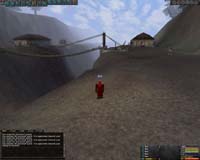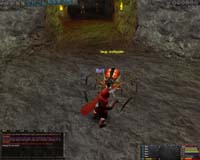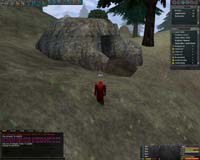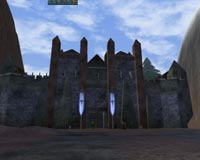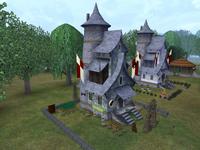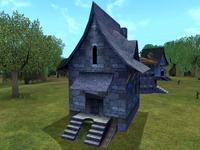|
|
|
Main News Forums Games Games Database Top 100 Release List Support Files Features Reviews Previews Interviews Editorials Diaries Misc Download Gallery Music Screenshots Videos Miscellaneous Staff Members Privacy Statement |
MMORPGDot Feature: Dark Age of Camelot Review In today's world of mmorpg's, there are well-established games against which the newcomers wish to compete. DAoC is one of those games that are considered "classic" by now. The game will be turning 3 years old later this year, and that is getting to be quite venerable by mmorpg standards. But the competition is fierce, and while newer games want to supplant the older, more established titles out there, games like DAoC are faced with the challenge to remain in top shape to be able to keep their players, even years after release. Dark Age of Camelot was already considered a good game in its early days, a worthy contender to EQ's crown, and it still remains one of the better mmorpgs on the market today, despite some of its flaws. Lands of Elves, Norse gods, and King Arthur
At its launch, DAoC was essentially regarded as a revamped version of EQ by some players, but it's admittedly much more than just that. The game's setting is sitting on the fence between mythology and fairytale, pitching three mythical realms (Albion - land of Arthurian Knights, Midgard - land of Norse god worshippers, and Hibernia - land of the magical Elves) against each other, and throwing a few fantasy classes in the mix like Avalonian Wizards, Dwarf Healers or drum-wielding Bards. The different settings are all well implemented, and quite varied between the three realms. And since you can't travel to opposing realms (except on the coop server on which you can play any race in any realm), this goes a long way in extending the life cycle of the game for even the most hardcore of players. Of course these three Realms are at each others' throats, and that's the central theme to the game, and also where DAoC's true appeal lies. While other games would offer players the chance to grind their character up to the higher levels and then leave them hanging, DAoC offers a true "end-game" in the form of Player-vs-player, or Realm-vs-Realm (RvR) as Mythic pegged it. The concept is simple and very appealing to all types of players, whether they enjoy PvP, or if they hate it with a passion. As long as a player remains within the borders of their own realm they need never fear death from another player (unless you choose to play on the hardcore, full-PvP server). To engage in PvP, a player actually needs to seek it out in the frontier realms, where anyone, from any realm, can venture to seek glory and fame. This all sounds nice and dandy, and it's been tried countless times before. But DAoC does it best. Those who want to avoid PvP have nothing to fear, and those who thrive by going after other players have ample opportunities to do so at almost every hour of the day. The Realm Wars are very active on pretty much every server DAoC has to offer (18 in North America alone), and it's the single best feature the game has to offer. The problem with DAoC rather lies on the road leading to the bliss of PvP. And it's a very long road indeed. Grind is the key
Before reaching that mark almost every class in the game can go at it solo with relative ease. In fact before level 20 it's almost always better to do things on your own. There are game elements in place to ease the passage of early levels, like kill tasks which ask you to kill a single specific mob which is around your level or lower. These tasks, and the early quests one might come across, help in familiarizing the player with his environment, as well as focusing his efforts into gaining experience fast, faster than by grouping in fact. But after level 20 these kill-tasks are no longer available, and some classes, particularly the casters, are by then most likely unable to fare well on their own. And even if they could solo they would be better off getting a good group to fight tougher opponents and gain experience faster. Although the road from level 1 to 20 was cleared in a matter of days the rest of the way to level 50 is likely to take someone weeks, even months unless the player is power-levelled by someone else at a higher level.
Since players can't hope to have any meaningful role to play in the Realm Wars until they reach at least level 40, this grind quickly becomes very frustrating, if not downright depressing at times. Mythic reacted early by implementing 4 battlegrounds which are only available to players of certain ranges of levels starting from 15 and up to 35, but some of them are so deserted that it becomes an exercise in patience when one is itching for a meaningful battle with other players. For the very patient among us only
Since all features of DAoC are constructed from the same mould, the same grinding feeling slowly creeps up on you once you reach the third tier of materials, which is about halfway through. Suddenly the player only gains one skill point for every 5 or 6 items he makes (if he's lucky), and it gets much, much worse from there. The more persistent players will spend hundreds of gold coins to achieve the top tier of their trade, and this in itself defeats the possibility of a player ever wishing to concentrate on trade skills without ever needing to take up weapons. You can take advantage of trade tasks which act like little fed-ex quests (make this item and bring it to NPC-X) and net you some nice profits. But once more this system is no longer available once you reach a certain (rather low) skill level. Mythic would have you believe that you can gain money by selling your wares after that, but in reality this only becomes true once you reach the higher levels of craft. By then you'll have already spent quite a bundle, and no one will have bought an item from you, except for the NPC that will buy it below the cost… Leaves in a Tree
|
|||||||||
|
All original content of this site is copyrighted by RPGWatch. Copying or reproducing of any part of this site is strictly prohibited. Taking anything from this site without authorisation will be considered stealing and we'll be forced to visit you and jump on your legs until you give it back. |
||





